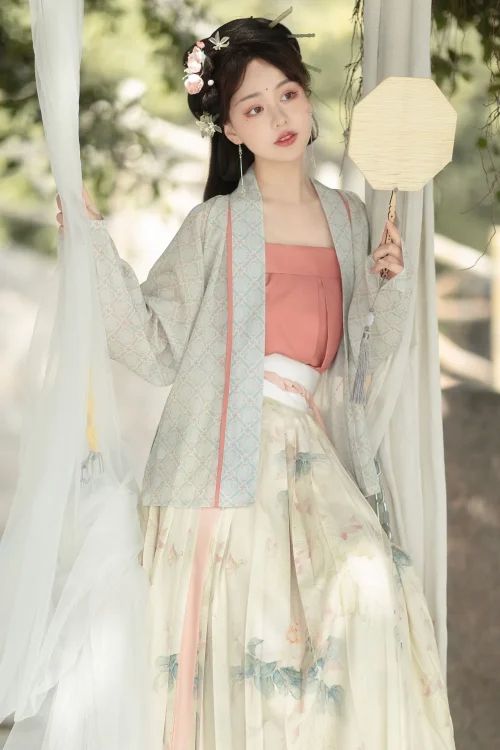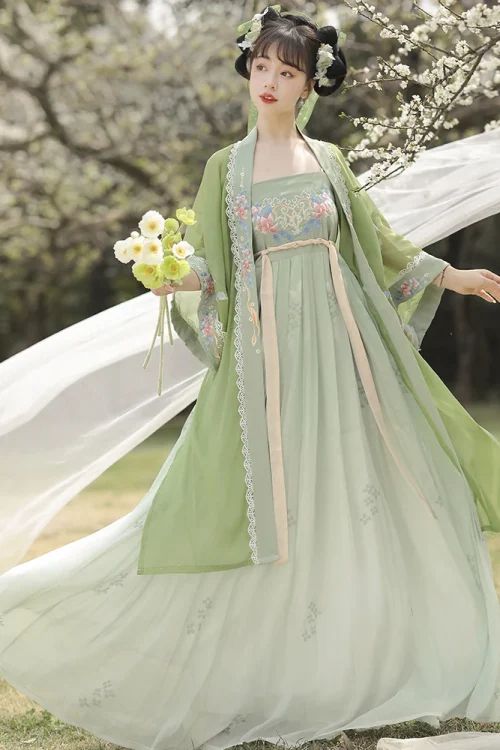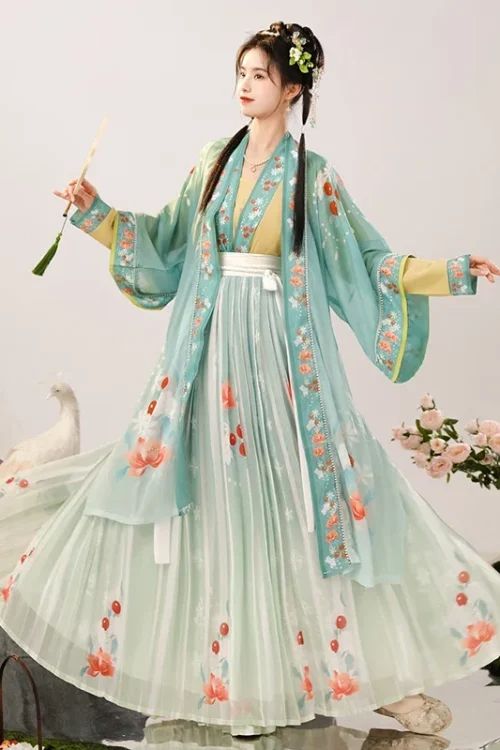Evolution of Hanfu Silhouettes: A Comparison of Song Era Styles with Preceding Dynasties
Throughout Chinese history, Hanfu, the traditional attire of the Han people, has undergone significant transformations in silhouette and style. This article focuses on the Song era (960-1279 CE), comparing its Hanfu styles with those of preceding dynasties.

Hanfu in the Tang Dynasty
During the Tang dynasty (618-907 CE), Hanfu silhouettes were characterized by flowing, wide sleeves and long, loose robes. Women’s attire often featured a low neckline and a long, trailing skirt. This era emphasized a sense of grandeur and freedom in fashion.
Transition to the Song Era
In contrast, Song era Hanfu exhibited a more restrained and elegant aesthetic. Sleeves became narrower and more fitted, while robes were shorter and more tailored. Women’s skirts were also shorter and more modest, with a higher waistline, reflecting the changing cultural values.
The Emergence of the Ruqun
One of the most distinctive features of Song era Hanfu was the emergence of the “ruqun,” a two-piece ensemble consisting of a short jacket and a long skirt. This style became popular among both men and women and was often worn with a sash or belt. The ruqun allowed for greater freedom of movement and was well-suited to the active lifestyle of the Song period.
Decorative Techniques
Another notable change in Song era Hanfu was the increased use of embroidery and other decorative techniques. Robes and skirts were often adorned with intricate patterns and motifs, reflecting the refined artistic sensibilities of the time. The use of silk and other luxurious fabrics also became more prevalent, adding to the overall elegance of Hanfu.
Layering Styles
In addition to the ruqun, other popular Hanfu styles during the Song era included the “beizi,” a long, loose robe worn by men, and the “shan,” a short, fitted jacket worn by women. These styles were often layered to create a more complex and sophisticated look.
Réflexion culturelle
The evolution of Hanfu silhouettes from the Tang to the Song era reflects the changing social and cultural values of the time. The more restrained and tailored styles of the Song period were in keeping with the emphasis on Confucianism and the pursuit of a harmonious and orderly society. Hanfu continued to evolve in subsequent dynasties, but the styles established during the Song era remained influential for centuries to come.
Embroidered Delights: Exploring the Exquisite Embroidery Techniques of Song Era Hanfu
Throughout Chinese history, Hanfu, the traditional attire of the Han people, has undergone significant transformations, reflecting the cultural and aesthetic sensibilities of each dynasty. Among these, the Song era (960-1279) stands out for its exquisite embroidery techniques, which adorned Hanfu with unparalleled elegance and artistry.

Flourishing Craft of Embroidery
During the Song dynasty, embroidery flourished as a highly refined craft. Skilled artisans employed a wide range of stitches and techniques to create intricate designs on silk and other fabrics. The most prevalent stitch was the “Suzhou embroidery,” renowned for its delicate and lifelike depictions of flowers, birds, and landscapes.
Popularity of Adorned Hanfu
The Song era witnessed a surge in the popularity of Hanfu adorned with embroidery. Women’s robes, known as “ruqun,” were often adorned with elaborate floral motifs, while men’s robes, called “changpao,” featured more subdued geometric patterns. The use of embroidery extended beyond clothing, as it also graced accessories such as fans, handkerchiefs, and purses.
Vibrant Color Palettes
One of the most striking features of Song era Hanfu embroidery was its use of color. Embroiderers employed a vibrant palette, with hues ranging from soft pastels to bold primaries. The harmonious blending of colors created a sense of depth and richness that enhanced the overall aesthetic appeal of the vêtements.
Innovative Techniques
The Song era also saw the emergence of new embroidery techniques, such as “gold thread embroidery” and “pearl embroidery.” Gold thread embroidery involved the use of fine gold threads to create intricate designs, while pearl embroidery incorporated pearls into the embroidery, adding a touch of opulence and sophistication.
Importance culturelle
The exquisite embroidery techniques of the Song era Hanfu not only reflected the artistic prowess of the time but also served as a testament to the cultural significance of Hanfu. The garments were not merely clothing but works of art that embodied the values and aspirations of the Song people.
Conclusion
In conclusion, the Song era Hanfu stands as a testament to the enduring beauty and artistry of Chinese embroidery. The intricate designs, vibrant colors, and innovative techniques employed by Song era artisans created garments that were both visually stunning and culturally significant. The legacy of Song era Hanfu embroidery continues to inspire contemporary designers and artisans, ensuring that this exquisite craft remains an integral part of Chinese cultural heritage.
Fabric and Dyeing Techniques: How Song Era Hanfu Reflects Technological Advancements
Throughout Chinese history, Hanfu, the traditional attire, has undergone significant transformations, reflecting the cultural and technological advancements of each era. The Song Dynasty (960-1279) marked a particularly notable period in Hanfu evolution, characterized by exquisite fabrics and innovative dyeing techniques.

Flourishing Textile Industry
During the Song era, the textile industry flourished, leading to the production of high-quality fabrics such as silk, cotton, and hemp. Silk, renowned for its luxurious texture and drape, became the preferred material for formal Hanfu. Cotton, known for its breathability and comfort, was widely used for everyday wear. Hemp, with its durability and moisture-wicking properties, was often employed for garments worn by laborers and soldiers.
Advancements in Dyeing Techniques
The Song Dynasty also witnessed advancements in dyeing techniques. Natural dyes derived from plants, minerals, and insects were used to create a vibrant palette of colors. Indigo, extracted from the indigo plant, produced deep blue hues, while safflower yielded rich reds. Yellow was obtained from turmeric, and green from gardenia. These dyes were applied using sophisticated techniques such as tie-dyeing, block printing, and embroidery, resulting in intricate and eye-catching patterns.
Distinctive Styles of Hanfu
The Song era Hanfu showcased these technological advancements through its distinctive styles. Formal robes, known as “changpao,” were typically made of silk and featured wide sleeves and flowing skirts. They were often adorned with elaborate embroidery and intricate patterns, reflecting the refined aesthetics of the time. Women’s skirts, called “qun,” were characterized by their graceful pleats and vibrant colors. They were often paired with short jackets or blouses, creating a harmonious and elegant ensemble.
Practical Functionality
In addition to its aesthetic appeal, Song era Hanfu also served practical purposes. The loose-fitting garments allowed for freedom of movement, making them suitable for everyday activities. The use of natural fibers ensured breathability and comfort, even in the hot and humid climate of southern China.
Conclusion
The technological advancements in fabric and dyeing techniques during the Song Dynasty had a profound impact on Hanfu. The exquisite fabrics and vibrant colors reflected the cultural sophistication and technological prowess of the era. These innovations not only shaped the aesthetics of Hanfu but also influenced its functionality and practicality. As a result, Song era Hanfu remains a testament to the ingenuity and artistry of Chinese artisans and a valuable cultural heritage that continues to inspire contemporary fashion designers.
